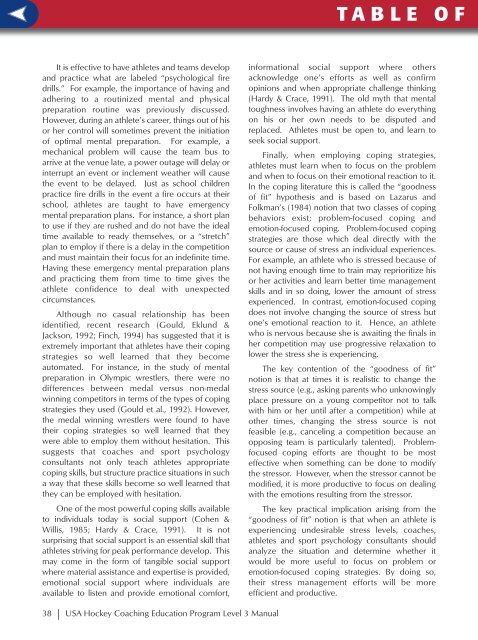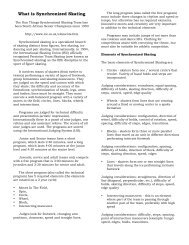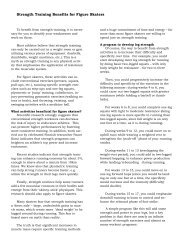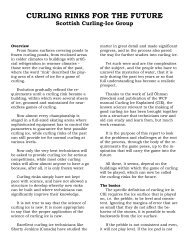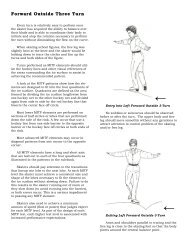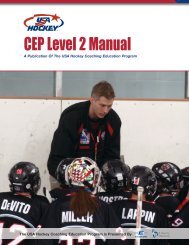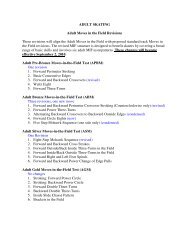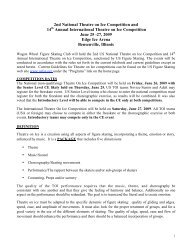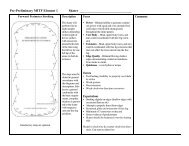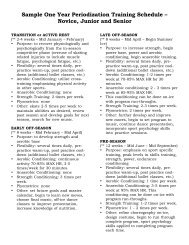CEP Level 3 Manual - Rushmore Hockey Association
CEP Level 3 Manual - Rushmore Hockey Association
CEP Level 3 Manual - Rushmore Hockey Association
Create successful ePaper yourself
Turn your PDF publications into a flip-book with our unique Google optimized e-Paper software.
T A B L E O F C O N T E N T SIt is effective to have athletes and teams developand practice what are labeled “psychological firedrills.” For example, the importance of having andadhering to a routinized mental and physicalpreparation routine was previously discussed.However, during an athlete’s career, things out of hisor her control will sometimes prevent the initiationof optimal mental preparation. For example, amechanical problem will cause the team bus toarrive at the venue late, a power outage will delay orinterrupt an event or inclement weather will causethe event to be delayed. Just as school childrenpractice fire drills in the event a fire occurs at theirschool, athletes are taught to have emergencymental preparation plans. For instance, a short planto use if they are rushed and do not have the idealtime available to ready themselves, or a “stretch”plan to employ if there is a delay in the competitionand must maintain their focus for an indefinite time.Having these emergency mental preparation plansand practicing them from time to time gives theathlete confidence to deal with unexpectedcircumstances.Although no casual relationship has beenidentified, recent research (Gould, Eklund &Jackson, 1992; Finch, 1994) has suggested that it isextremely important that athletes have their copingstrategies so well learned that they becomeautomated. For instance, in the study of mentalpreparation in Olympic wrestlers, there were nodifferences between medal versus non-medalwinning competitors in terms of the types of copingstrategies they used (Gould et al., 1992). However,the medal winning wrestlers were found to havetheir coping strategies so well learned that theywere able to employ them without hesitation. Thissuggests that coaches and sport psychologyconsultants not only teach athletes appropriatecoping skills, but structure practice situations in sucha way that these skills become so well learned thatthey can be employed with hesitation.One of the most powerful coping skills availableto individuals today is social support (Cohen &Willis, 1985; Hardy & Crace, 1991). It is notsurprising that social support is an essential skill thatathletes striving for peak performance develop. Thismay come in the form of tangible social supportwhere material assistance and expertise is provided,emotional social support where individuals areavailable to listen and provide emotional comfort,informational social support where othersacknowledge one’s efforts as well as confirmopinions and when appropriate challenge thinking(Hardy & Crace, 1991). The old myth that mentaltoughness involves having an athlete do everythingon his or her own needs to be disputed andreplaced. Athletes must be open to, and learn toseek social support.Finally, when employing coping strategies,athletes must learn when to focus on the problemand when to focus on their emotional reaction to it.In the coping literature this is called the “goodnessof fit” hypothesis and is based on Lazarus andFolkman’s (1984) notion that two classes of copingbehaviors exist; problem-focused coping andemotion-focused coping. Problem-focused copingstrategies are those which deal directly with thesource or cause of stress an individual experiences.For example, an athlete who is stressed because ofnot having enough time to train may reprioritize hisor her activities and learn better time managementskills and in so doing, lower the amount of stressexperienced. In contrast, emotion-focused copingdoes not involve changing the source of stress butone’s emotional reaction to it. Hence, an athletewho is nervous because she is awaiting the finals inher competition may use progressive relaxation tolower the stress she is experiencing.The key contention of the “goodness of fit”notion is that at times it is realistic to change thestress source (e.g., asking parents who unknowinglyplace pressure on a young competitor not to talkwith him or her until after a competition) while atother times, changing the stress source is notfeasible (e.g., canceling a competition because anopposing team is particularly talented). Problemfocusedcoping efforts are thought to be mosteffective when something can be done to modifythe stressor. However, when the stressor cannot bemodified, it is more productive to focus on dealingwith the emotions resulting from the stressor.The key practical implication arising from the“goodness of fit” notion is that when an athlete isexperiencing undesirable stress levels, coaches,athletes and sport psychology consultants shouldanalyze the situation and determine whether itwould be more useful to focus on problem oremotion-focused coping strategies. By doing so,their stress management efforts will be moreefficient and productive.SUMMARYIf an athlete is going to consistently achievepeak performances a variety of mental preparationskills must be developed. This presentation has triedto organize key mental preparation skills into apyramid model of peak performance. All threecomponents of the model must be developed andcontinually refined. However, it is critical torecognize that no standardized set of mentalpreparation skills exist, and although the mostgeneric skills, considerable individual differencesand variation in strategy use is evident. Hence,while those choosing to use the model to guidepractice will find the general strategies andguidelines useful, it is critical that an awareness andappreciation of individual differences be recognizedand mental preparation programs modifiedaccordingly. By doing so, the model will be mosteffective in guiding practice.REFERENCESBandura, A. (1982). Self-efficacy in human agency. AmericanPsychologist, 37, 122-147.Barnett, N.P., Smoll, F.L., & Smith, R.E. (1992). Effects of enhancingcoach-athlete relationships on youth sport attrition. The SportPsychologist, 6, 111-127.Boutcher, S.H. (1990). The role of performance routines in sport. In J.G.Jones & L. Hardy (Eds.). Stress and performance in sport (pp. 231-245). Sussex, UK: John Wiley & Sons.Burton, D. (1992). (1992). The Jekyll/Hyde nature of goals:Reconceptualizing goal setting in sport. In T. S. Horn (Ed.).Advances in Sport Psychology (pp. 257-297). Champaign, IL:Human Kinetics.Cohen, S. & Willis, T. (1985). Stress, social support and the bufferinghypothesis. Psychological Bulletin, 98, 310-357.Cohn, P.J. (1990). Pre-performance routines in sport: Theoreticalsupport and practical applications. The Sport Psychologist, 3, 301-312.Danish, S.J., Petitpas, A., & Hale, B. (1995). Psychological interventions:A life development model. In S. M. Murphy (Ed.). Sportpsychology interventions (pp. 19-38). Champaign, IL: HumanKinetics.Duda, J.L. (1993). Goals: A social cognitive approach to the study ofachievement motivation in sport. In R. N. Singer, M. Murphey, &L.K. Tennant (Eds.). Handbook of research on sport psychology.NY: MacMillan Publishing.Finch, L.M. (1994). The relationship among coping strategies, traitanxiety, and performance in collegiate softball players. Paperpresented at the <strong>Association</strong> for the Advancement of AppliedSport Psychology Conference, Lake Tahoe, Nevada.Gould, D. (1993a). Goal setting for peak performance. In J. M. Williams(Ed.). Applied sport psychology: Personal growth to peakperformance (second edition) (pp. 158-169). Mountain View, CA:Mayfield.Gould, D. (1993b). Intensive sport participation and the prepubescentathlete: Competitive stress and burnout. In B. R. Cahill & A.J. Pearl(Eds.). Intensive sports participation in children’s sports (pp. 19-38).Champaign, IL: Human Kinetics.Gould, D. & Damarjian, N. (in press a). Imagery training for peakperformance. In J. L. Van Raalte & B.W. Brewer (Eds.). Apractitioner’s guide to sport and exercise psychology. Washington,D.C.: American Psychological <strong>Association</strong>.Gould, D. & Damarjian, N. (in press b). Mental skills training in sport. InB. C. Elliot (Ed.). Applied sport science: Training in sport.International Handbook of Sport Sciences – Vol. 3. Sussex,England: John Wiley & Sons, Inc.Gould, D., Eklund, R.C., & Jackson, S.A. (1992). 1988 U.S. Olympicwrestling excellence: I. Mental Preparation, pre-competitivecognition and affect. The Sport Psychologist, 6, 344-357.Gould, D., Finch, L.M. & Jackson, S.A. (1993). Coping strategies used bynational champion figure skaters. Research Quarterly for Exerciseand Sport, 64, 453-468.Gould, D., Jackson, S.A., & Finch, L.M. (1993). Sources of stress innational champion figure skaters. Journal of Sport and ExercisePsychology, 15, 134-159.Gould, D., Udry, E., Tuffey, S. & Loehr, Jr. (1994). Burnout in competitivejunior tennis players: I. Introduction to the project. Manuscriptsubmitted for publication.Hardy, C. & Crace, K. (1991). Social support within sport. SportPsychology Training Bulletin, 3(1), 1-8.Hardy, L., Jones, G. & Gould, D. (in press). Psychological preparation forelite athlete performance: Theory and practice. Sussex, UK:Wiley.Lazarus, R.S. & Folkman, S. (1984). Stress, Appraisal and coping. NewYork: Springer.Louganis, G. & Marcus E. (1995). Breaking the surface. New York:Random House.McAuley, E. (1992). Self-referent thought in sport and physical activity.In T. S. Horn (Ed.). Advances in Sport Psychology (pp. 101-118).Champaign, IL: Human Kinetics.Murphy, S.M. (1995). Transitions in competitive sport: Maximizingindividual potential. In S. M. Murphy (Ed.). Sport psychologyinterventions (pp. 334-346). Champaign, IL: Human Kinetics.Orlick, T. (1986). Psyching for sport. Champaign, IL: Leisure Press.Orlick, T., & Partington, J. (1988). Mental links to excellence. The SportPsychologist, 2, 105-130.Smith, R. E. & Smoll, F. L. (1995). The coach as the focus of research andintervention in youth sports. In F. L. Smoll & R. E. Smith (Eds.).Children and youth in sport: A biopsychosocial perspective. (pp.125-1410). Madison, WI: Benchmark.Smith, R. E., Smoll, F. L., & Barnett, N. P. (1995). Reduction of children’ssport performance anxiety through social support and stressreductiontraining for coaches. Journal of DevelopmentPsychology, 16, 125-142.Vealey, R. (1992). Personality in sport: A comprehensive view. In T. S.Horn (Ed.). Advances in Sport Psychology (pp. 25-29).Champaign, IL: Human Kinetics.Vealey, R.S. & Walters, S. M. (1993). Imagery training for performanceenhancement and personal development. In J. M. Williams (Ed.).Applied sport psychology: Personal growth to peak performance(second edition) (pp. 200-224). Mountain View, CA: Mayfield.Weiss, M. R. & Chaumeton, N. (1992). Motivational orientations insport. In T. S. Horn (Ed.). Advances in Sport Psychology (pp. 61-99). Champaign, IL: Human Kinetics.Williams, J. M. & Krane, V. (1993). Psychological characteristics of peakperformance. In J. M. Williams (Ed.). Applied sport psychology:Personal growth to peak performance (second edition) (pp. 137-147). Mountain View, CA: Mayfield.38 | USA <strong>Hockey</strong> Coaching Education Program <strong>Level</strong> 3 <strong>Manual</strong>Sport Psychology | 39


